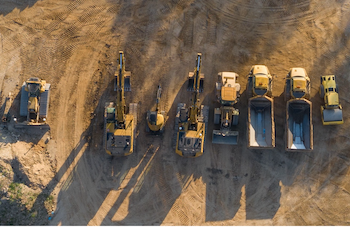CO2 emissions reporting
Trackunit offers Emissions Reporting software which will significantly enhance fleet owners’ ability to meet CO2 targets and win contracts with strict sustainability criteria.
 |
| Whole fleet emission reporting is essential for OEMs, rental and contractors as the market increases its requirement to demonstrate lower carbon emissions. |
Emissions Reporting harnesses synthesized machine metadata and individual equipment profiling to unlock comprehensive total fleet emissions reporting for off-highway machines and equipment, something the sector has been unable to do until now.
“Construction is complex and that has made it difficult for the industry to get really accurate figures on emissions,” says Lærke Ullerup, Trackunit’s chief marketing and product manager. “The solution and data model is uniquely able to include all equipment, connected and non-connected, using machine learning and the vast data pool to deliver emissions reporting with high accuracy. Effectively, it means no machine will be left behind.”
Ullerup says that the new software will put an end to the practice of ‘guesstimating’ emissions numbers which will become increasingly important over the coming years. That’s because government- or state-mandated projects now typically require a raft of emissions-reporting stipulations that put an onus on contractors to demonstrate they are not just tracking, but also reducing their emissions, she said.
“This software effectively puts users ahead of the game in a regulatory environment that is only moving in one direction in line with net-zero global targets,” said Ullerup. “It’s a critical addition to any construction company’s kit to develop their business, build profitability and contribute to a greener industry.”
The software can be used on every type of machine in the off-highway sector and gives users an at-your-fingers display of emissions from all connected equipment enabling easy tracking and, where necessary, almost instantaneous action to reduce emissions through the value chain.
“Our benchmark here is the car dashboard and while we’re not yet at a stage where we can emulate the kind of insight developed by the automotive industry, that has to be the kind of standard we adhere to,” says Ullerup. “That will help construction mimic how the car industry has partly been led by EU legislation to very effectively create a culture of ownership with its customers to take responsibility for their emissions in a relatively short period of time.
“We believe this new software in tandem with regulatory changes can help bring about a similar culture shift right down to the individual operators of machines,” Ullerup said.
Emissions Reporting should also enable smarter deployment decisions to avoid the under-utilization of machinery, ensure fleets are in line for tax-saving benefits where local authorities incentivize better tracking, and also offer an abundance of brand-building opportunities through data-based validation of sustainability claims.
“This is a game changer and comes at a critical global juncture as construction does everything it can to eliminate downtime and mitigate against climate change,” said Ullerup. “Construction is responsible for circa 38% of global emissions so even moving that figure down just one percentage point would have a significant absolute effect on overall emissions.”








